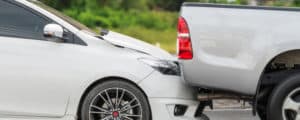
into the back of another vehicle, you may wonder, “Is the driver in the back always at fault for a rear-end collision?”
Is the Driver in the Back Automatically at Fault for a Rear-End Crash?
The short answer is: No. In Texas, one motorist, both drivers, or neither party can be deemed at fault for a fender-bender. Many people assume that the driver in the back is automatically at fault for a rear-end accident since traffic laws require motorists to maintain a safe distance between vehicles.
Maintaining a safe following distance between motor vehicles is important for a reason. If the lead vehicle stops, the driver in the back should have a reasonable amount of time to react in time to stop.
In other words, a driver in the back is not automatically at fault if they crash into a vehicle in front of them since the lead driver’s negligence may contribute to the accident, too. If you were involved in a rear-end crash, contact a Corpus Christi car accident attorney to determine who is to blame for the collision and help you pursue compensation from the at-fault party.
Negligence in Rear-End Accidents in Texas
Since Texas follows the doctrine of modified comparative negligence, both motorists can be held liable for the rear-end collision. In rare cases, however, neither driver is to blame for the accident.
In Texas, multiple parties may be found negligent for an accident, while their compensation would be reduced by the percentage of their own fault. Under Texas law, negligence is defined as a party’s failure to act as a person of reasonable and ordinary prudence would have acted under similar circumstances.
In addition to proving that the other driver was negligent, you also need to demonstrate evidence that their negligence was a proximate cause of your injury in order to recover damages after a rear-end accident.
Rear-End Crashes and Comparative Negligence in Texas
In Texas, more than one driver can be found negligent in a rear-end crash. When it comes to determining liability for an auto accident, the court will assign a percentage of fault to each party involved. If your percentage of fault amounts to 0%, you are entitled to 100% of the total damages.
If your negligence is determined to be 20% while the total amount of damages is $100,000, your compensation will be reduced by 20% ($100,000 – 20% = $80,000). However, if your negligence of fault exceeds 50%, you are not entitled to any compensation in the State of Texas.
Can the Driver in the Front Be at Fault for a Rear-End Accident?
In many rear-end collisions, the driver who was hit from the back can be partially or even fully at fault for causing the crash, as absurd as it may sound. Examples of when the lead driver can be found negligent in a rear-end accident include:
- The driver in the front cuts someone off and causes a vehicle in the back to crash into them.
- The lead driver fails to use turn signal as any reasonably prudent motorist would, resulting in a rear-end accident.
- The driver in the front slams on the brakes or slows suddenly and unexpectedly, making it impossible for the driver in the back to react in time to avoid a collision.
In all of these examples, the lead driver is likely to be found fully or partially responsible for causing a rear-end crash. However, since each case is unique, it is vital to consult with a knowledgeable car accident attorney in Corpus Christi to establish fault in your particular case.
In some cases, neither driver can be held at fault for a rear-end accident. An example of a rear-end crash in which neither party is responsible for the collision is an unavoidable accident. In Texas, an unavoidable accident is any crash that is not caused by the negligence of any party involved (e.g., a deer darting into the road, causing the lead driver to hit the brakes).
To summarize: In Texas, the driver in the back is not automatically at fault for a rear-end accident.
If you were injured in a rear-end collision in Corpus Christi or other parts of Texas, speak with our skilled personal injury attorney David T. Burkett to help you establish fault in your particular case and recover damages through all available sources. Call at 361-882-8822 for a case review.





